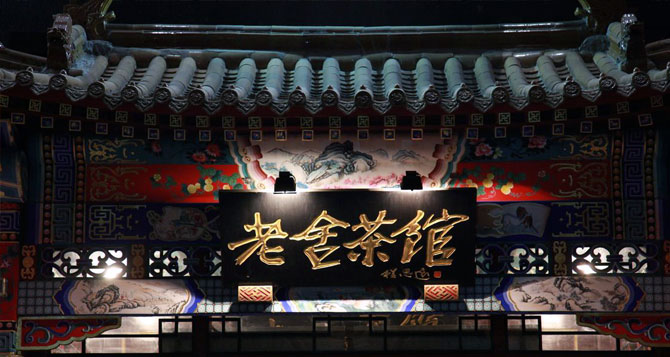Laoshe Teahouse — About The Show

The Teahouse
This teahouse, Lao She, stands right on the front of West Main street, in a three-storey pavilion, and has a modern contemporary feel but also retains the classical charisma of a traditional teahouse. There are two large swaying red lanterns decorating its front door and the four Chinese characters of “Lao She Cha Guan” engraved proudly on the suspended ornate sign. It brings back sentimental memories of Mr. Lao She’s drama “The Teahouse”.
As I drew aside the two red curtains and entered, even before my foot touched the floor, I was greeted by a young waiter: “Sir, are you here to drink tea or would you like to have something to eat?” The waiter wore a round hat, with a blue jacket and a white towel draped on his shoulder; he bowed and looked at me cheerfully. This typical greeting from the waiter again brought back reminiscences from one of the original teahouses.
On the wall of the first floor there is a brief introduction to the history of the Lao She Teahouse. The small living room contained three musical instruments: a dulcimer, an erhu and a table with bowls of different sizes. A lady in a cheongsam gently tapped the sides of the bowls with the hammer used for striking the dulcimer, making some crisp ding-dong notes and producing a simple, yet lucid and lively melody, whilst improvising with the other two musicians.
“Please go upstairs sir!” With the sonorous Pekingese accent of the young waiter ringing in my ears, I walked up to the second floor. The second floor is set out with all kinds of porcelain as well as opera puppets playing an opera theme; there were also various tealeaves displayed from across the country. The tea sets are exquisitely made of delicate and dense purple porcelain, illustrating some of the finest examples of Chinese tea sets. There were also dolls kneaded from dough, and with the teahouse as their background, they looked particularly expressive and lifelike. This second floor depicts the unique nuances of both the tea culture and old Peking culture, which are harmoniously and cleverly integrated, showing the uniquely Chinese art of the teahouse.
The Performance
Walking up the crimson coloured pine stairs to the third floor, I finally arrived to where the opera was going to be performed. Right up at the front is a dark curtain decorated with the four big Chinese characters of “Lao She Cha Guan”, covering the stage behind. Right beneath it is the seating area where we were to watch the play. It was just as one would have imagined, mahogany tables surrounded by wooden benches, loaded with tea in exquisite yellow covered cups; the brewed red tea was exactly what you wanted to drink in the winter season! Four blue and white porcelain small square dishes were filled with an abundance of wonderful snacks, including melon seeds and preserved fruits. Watching the opera whilst drinking fine tea and delicate snacks, the vivid images of old Peking came alive again.
The opening act featured a rich voice performing an aria, accompanied by a three stringed musical instrument.
Then came an incredibly skilful acrobat, balancing a porcelain jar of at least 20kg on his head whilst the shadow of a hand in the background seemed both real and imaginary at the same time!
Whilst old time operas often boringly repeated the same old arias, here in the third act, there was a modern variation of the “Picking up the Bracelet”. It made you marvel at the agility of this modern Peking opera, while preserving the special appeal of a traditional opera. With only three characters, they managed to amuse everyone and there was continuous applause!
Watching “face changing” on a TV screen would have been an amazing sight, but watching it live from such a close distance is definitely an incredible feast for the eyes. With just a gentle wave, the actor’s face totally changed. Even as we were shaking hands, he managed to change from Guan Gong to the Monkey King.
During the intervals, young waiters walked around, selling candied fruit and Western cigarettes, with authentic shouts. It felt as if you were back in the old alleys of Peking surrounded by children with braided horns in their hair, holding copper coins, excitedly running up to buy some authentic Peking candied fruit and then savouring these skewers of sweetness.
This was an incredible experience, with teacup in one hand and the cover in the other, concentrating on the opera, relishing quality tea, tasting the candied fruits of old Peking and not forgetting to applaud on time!
This is a wonderful feast for the spirits, helping to enhance our artistic side.
